Sexing Caudates
By Jennifer Macke
What species is it? Every species has different sex characteristics, so first make sure you know what species you have.
Two general rules:
- Often, the male has a larger cloaca. This rule does not apply to all species, and the difference may only be noticable during the breeding season.
- Often, the female is larger and/or more plump. This rule applies only if the animals compared are healthy, mature, well-fed, and similar ages.
There may be no way to know. Some species cannot be sexed outside of the breeding season. If you don't have both a male and female for comparison, you might not be able to discern the difference. Also, immature animals (larvae, juveniles, and efts) are almost always impossible to sex.
Sexing some NEWT species
Chinese Firebelly newts (Cynops orientalis). If you aren’t sure which kind of firebelly newt you have, read the article “What Kind of Fire Belly Is It?” Chinese firebellies can be sexed by the two general rules defined above. Notice in the photos that the male has a indentation right behind the cloaca, lacking in the female.
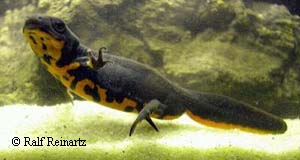 Male C. orientalis. |
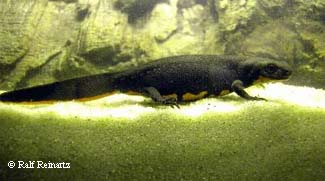 Female C. orientalis. |
Japanese Firebelly newts (Cynops pyrrhogaster). Japanese firebellies can also be sexed easily by the two general rules. In addition, males often have longer toes. During the breeding season, the males often get gray or blue highlights on their skin, particularly on the tail.
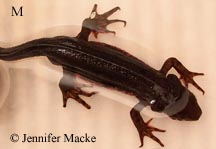 |
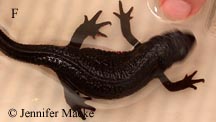 |
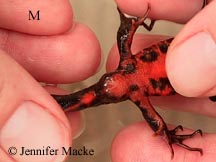 |
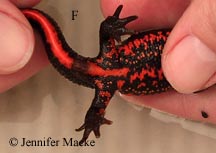 |
Eastern, red-spotted, or broken-striped newts (Notophthalmus viridescens). Outside of breeding season, eastern newts have no consistent difference in the size of the cloaca. The sexes are distinguished by the width of the back legs. During the breeding season, the males may exhibit a larger cloaca and nuptial pads on the underside of the back legs and back toes.
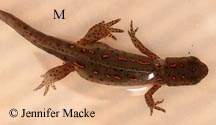 |
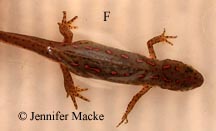 |
Paddletails (Pachytriton labiatus). The general rule about the cloaca holds true. Females are fairly ‘flat’ while males have an obvious cloaca. During breeding season, the male may have white spots on his tail and papillae may be visible.
Western newts (Taricha granulosa). The general rule about the cloaca holds true. During breeding season, the males get smoother, spongy, slimy skin and nuptial pads on their legs and toes.
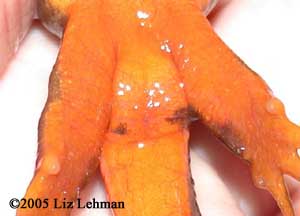 Taricha granulosa male |
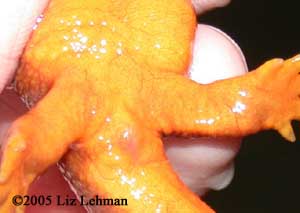 Taricha granulosa female |
Mandarin, crocodile, Kweichow newts (Tylototriton spp.). The cloaca sizes are not very different, but the male’s may be slightly larger in proportion to his body size. The male’s cloaca will have a longer slit length. Males may also have slightly wider front legs. Females are often both longer and fatter.
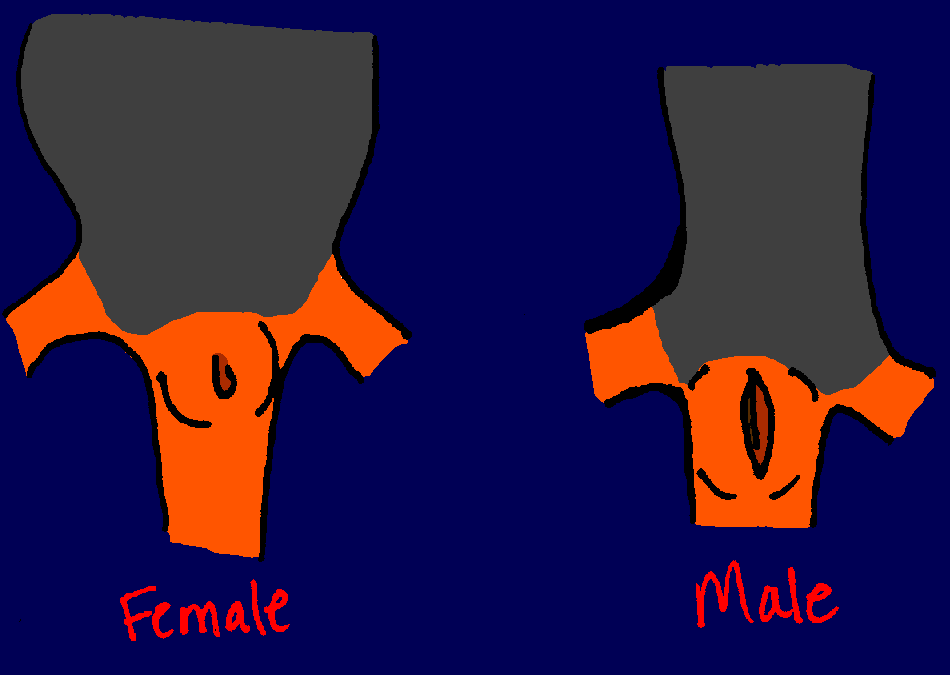 |
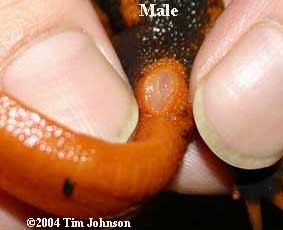 Tylototriton kweichowensis male |
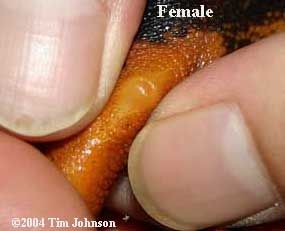 Tylototriton kweichowensis female |
Spanish ribbed newts (Pleurodeles waltl). Cloaca size is not a good indicator. Males have wider front legs, used for clasping the female. Females have proportionately shorter tails and fatter abdomens. However, these differences are very difficult to distinguish unless you have a male and female side by side. During breeding season, the male may become slightly reddish. He develops nuptial pads on the underside of the front legs, and the region at the base of the tail becomes wider.
Spotted newts (Neurergus strauchii). Outside of breeding season, the sexes may be difficult to distinguish. In season, the female develops a "volcano-shaped" cloaca; it protrudes, but does not have the overall swollen appearance of a male. The male's cloaca enlarges, and he develops blue-white highlights on the tail and flanks. The female is generally larger and plumper than the male, but this species has a generally slim physique, so a female with eggs may not look as fat as most gravid newts.
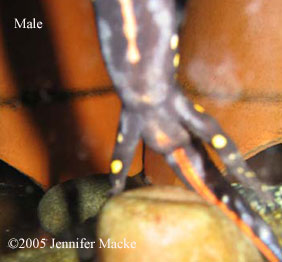 Neurergus strauchii strauchii male |
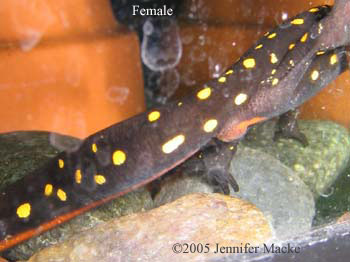 Neurergus strauchii strauchii female |
Crested, marbled, banded, and alpine newts (Triturus spp.). The general rule about the cloaca holds true. During breeding season, the males develop some form of adornment such as a higher tail fin, and their papillae may be visible. During breeding season, males of some Triturus species get a prominent crest and a white stripe on the tail or other changes in coloration.
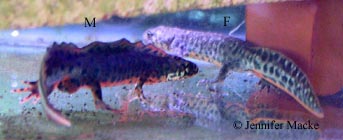 |
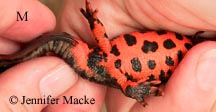 |
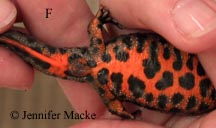 |
Warty newts (Paramesotriton spp.). It is difficult just to identify the species of some warties, so this group is particularly difficult. Some species are easy to sex, while others are difficult.
P. chinensis. In breeding season, the male has an enlarged cloaca (below left), while the female has a volcano-shaped cloaca (below, right). The male gets a blue-white tail stripe during breeding season (below, center).
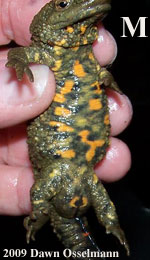 |
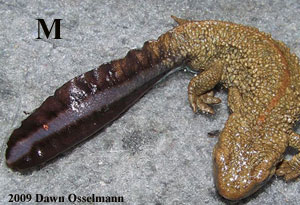 |
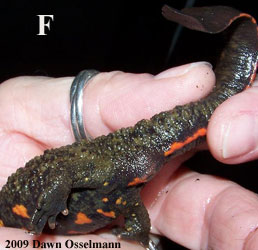 |
P. guangxiensis. The general rule about the cloaca holds true.
P. hongkongensis. Outside of breeding season, the cloaca of the male and female are identical. Females may have somewhat longer tails in proportion to their total length. The male gets a blue-white tail stripe during breeding season.
P. caudopunctatus. Males always have some color along the sides of the tail, which becomes more prominent during breeding season. Females rarely have any such markings.
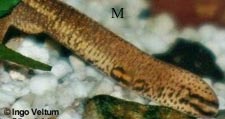 |
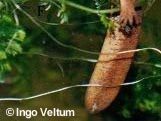 |
Sexing some SALAMANDER species
Axolotls (Ambystoma mexicanum). The male has a larger cloaca.
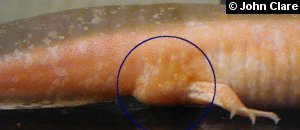
|
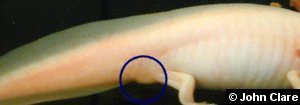
|
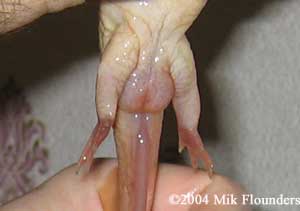
|
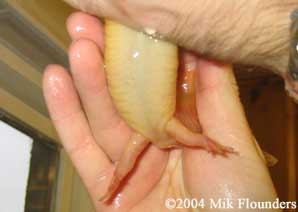
|
Tiger, marbled, and spotted salamanders (Ambystoma spp.). The general rule about the cloaca holds true. Because they tend to be obese in captivity, a plump body may not always indicate a female.
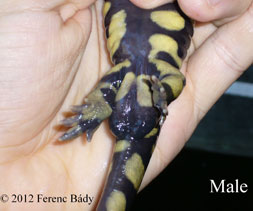
|
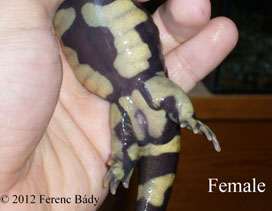
|
Siren (Siren lacertina). Males have two humps on their head due to their enlarged masseter muscles, while in females the top of the head is nearly flat.
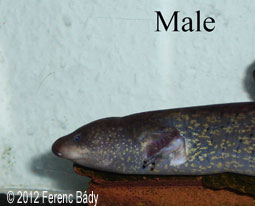
|
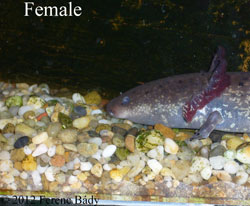
|
Fire salamanders (Salamandra salamandra). The general rule about the cloaca holds true. The sex should be distinguishable after they reach about 6 inches (15 cm) in length.
Redback salamanders (Plethodon cinereus). Males have enlarged upper lips around the nasolabial groove region, and a mental gland under the chin.
Slimy salamanders. (Plethodon glutinosus) and Jordan’s salamanders (Plethodon jordani). Males have a mental gland under the chin, females do not. It is visible during breeding season, but is not always obvious when the males aren't in season.
Slender salamanders. (Batrachoseps spp). Males are smaller and slimmer overall. Males have an enlarged mental gland.
Ensatinas (Ensatina spp). Males have a larger upper lip, are more slender overall, and have longer tails.
Hynobius spp. The size and shape of the cloacas differ. Hynobius nigrescens is shown.
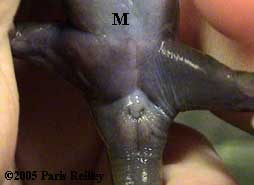
|
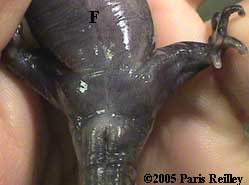
|
Mudpuppy (Necturus maculosus). Male vent has a crescent-shaped transverse groove, and two nipple-like papillae at the rear of the vent.
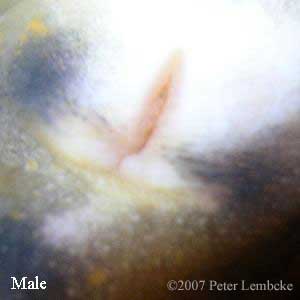
|
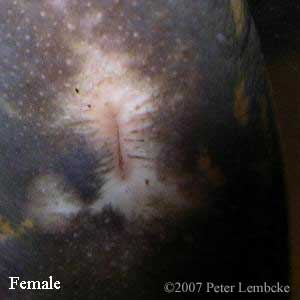
|
GLOSSARY
Cloaca. (kloe-AY-kuh). The common cavity into which the intestinal, urinary, and reproductive canals open in birds, reptiles, amphibians, many fish, and certain mammals. See photo of axolotls above.
Papillae. (pa-PILL-ay). Small hair-like structures that protrude from the cloaca of the male during breeding season. The term "papillae" can also refer to nub-like protrusions (see photo of mudpuppy, above).
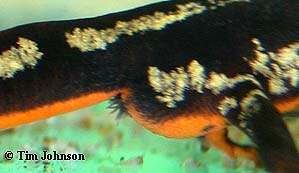
|
Nasolabial groove. See illustration.
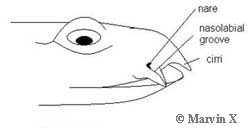 |
Mental gland. A round gland under the chin of the males of some species. See photo.
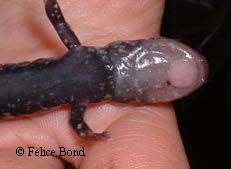 |
Nuptial pads. Black, hardened skin on the underside of the legs and toes of the male during breeding season. See photo.
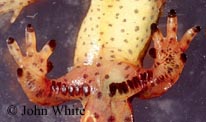
|
Tail gland. Gland on top of the male's tail, shown here on Eurycea multiplicata.
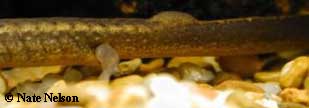
|
Tail spike. Small spike near the base of the tail. This feature is unique to the male of the species Mertensiella caucasica.
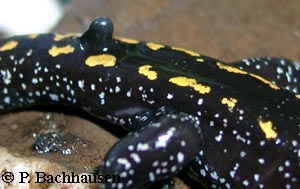 |
References
Petranka, J.W. 1998. Salamanders of the United States and Canada. Washington: Smithsonian Institution Press.
AmphibiaWeb: Information on amphibian biology and conservation. 2002. Berkeley, California: AmphibiaWeb. Available: https://amphibiaweb.org/. (Accessed: May 2002).
© Jennifer Macke, July 2002. Revised November 2009.
